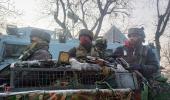'Unlike on the western and eastern borders where there is an enemy at the gate, here there is an invisible enemy which is building its own capability and can come into play at a time and place of his choosing.'

It is a hot Saturday morning in Port Blair and the new occupant of Command House, Air Marshal Saju Balakrishnan, AVSM, VM and his wife are just settling in.
The air marshal is the new Commander-In-Chief of the Andaman and Nicobar Command -- CINCAN -- the only tri-services theatre command of the Indian armed forces which has enormous strategic and economic importance.
He is the first IAF officer in 10 years to assume the post which is rotated among the Indian Army, Indian Navy and Indian Air Force.
The couple's luggage has not yet arrived from the mainland. Port Blair is located about 1,400 kilometres by air from Chennai and is surrounded by the magnificent blue waters of the Bay of Bengal.
The garden at Command House overlooks the ocean and provides a picturesque setting. It is the weekend and the air marshal, a MiG-21 fighter pilot, has just picked up the baton from the previous CINCAN who retired on April 30.
His responsibilities will include a combination of coastal security, providing support to the Andaman and Nicobar administration in multiple areas and most importantly, contributing to the strategic security of the nation.
The A&N theatre comprises a vast expanse of the Indian Ocean which constitutes a large part of the Indian coastline. The protection and security of the around 800 islands is the responsibility of this command.
The air marshal commanded one of the IAF's biggest stations in Jodhpur, headed the Airborne Warning and Control System unit and formulated the training module of the Agniveers's induction into the IAF.
"The good part of this command is that it brings together the strengths of the Army, Navy, Air Force, and also the Coast Guard," says the alumnus of the famous Sainik School Kazhakootam with a voice of calm authority.
"The future will be determined by the way India enhances its capability in this region," Air Marshal Balakrishnan tells Rediff.com's Archana Masih and Nikhil Lakshman at his official residence in Port Blair.
What makes the Andaman and Nicobar Command different? What are the unique challenges pertaining to the Andaman and Nicobar islands?
It has enormous strategic and economic importance. The future will be determined by the way India enhances its capability in this region. So much of global shipping goes through this region and the government clearly understands that we need to enhance our capability.
We have a number of challenges here, first is the distance. Material resources for development tasks have to be brought from the mainland or imported from neighbouring countries.
Secondly, it is very ecologically sensitive and any development has to be ecologically balanced.
It is a vast expanse of the Indian Ocean with a large part of the Indian coastline and around 800 islands that have to be protected.
Security is a challenge and even if we were to induct all our resources, it would be difficult to police and secure the region considering the vastness of the region.
Therefore, we cannot use the typical patrolling pattern of dividing the region into areas and conducting searches and patrols; we have to be smart and use intelligence sources which can indicate that a particular aspect can become a threat.
The ISR (Intelligence, Surveillance, Reconnaissance) capability has to be enhanced. Coastal security is a combination of shore-based security and unmanned aerial vehicles systems.
The good part of this command is that it brings together the strengths of not just the Army, Navy, Air Force, but also the Coast Guard.
All these arms are well meshed. My predecessors have done a great job in seamlessly connecting the operations, administration and maintenance.

What will be the challenges of this command?
It will be a combination of coastal security, providing support to the Andaman and Nicobar administration in multiple arenas and most importantly contributing to the strategic security of the nation.
Unlike on the western and eastern borders where there is an enemy at your gate, here there is an invisible enemy which is building its own capability and can come into play at a time and place of his choosing. We have to be prepared for it.
As an Air Force officer, how do you think you can contribute to this process?
The Air Force is the first and the fastest responder to any crisis and as an IAF officer I can channelise those resources most effectively.
I could also bring my own experience and professional knowledge in the present role.
Is it because of new advances in aerial reconnaissance and combat that an Air Force officer was appointed CINCAN?
No, it is a rotational post. Each service brings a plethora of experiences and what you learn in your own service can be merged with the existing culture.
It is a sum of all parts; one individual cannot make the difference by himself.
What have been the high points of your military career?
1. The first solo is very special to an aviator. It is a unique experience. It is something to be lived through to actually understand the pleasures of flying.
2. The first time I participated in an Operation Readiness Platform mission. It is what you train for which gets your adrenalin pumping. Most of the ORPs don't really materialise in an engagement, but it gives you a high.
3. When I took command of a fighter squadron, which is what every pilot aspires for from the time he joins the air force.
4. My most critical post was when I was in the AWACS programme. In the first year we were involved in selection, training and inducting -- and then we made it operational. The three years were a great learning value because the system was very complex. I had a team from across all the branches of the air force and we had to function as one team.
We learned on the job and spent a lot of time working on this immense platform from 2008 to 2011. It was a big challenge and very rewarding for me.
5. When I was air officer commanding of one of the largest bases (Jodhpur) which had 5 flying units alone and almost about 40 other units. Operationally, it is one of the critical bases in Indian Air Force.
That was very rewarding, both for me and my wife. It was a huge station, 5,000 uniformed personnel and if you include families and other allied units it was close to 20,000 people. Our task was to ensure their welfare.
6. Most recent was the induction of Agniveers. I was in the training command and in charge of this new concept. We had to be very precise in the aspects of training which was a big challenge. I think we've done a good job and when I meet them, I find they are on the right track.

Are the Agniveers combat efficient?
They are proficient for what we have decided they will do. In the early days, personnel were trained in a holistic manner because they were expected to do everything. But now, there is a focussed change where the field of work has been defined.
We are very clear about what they will be expected to do in the first year after joining. After that, there will be an up-skilling module, where we will take them to the next level and then progressively build them up rather than expect them to do everything about our trade or branches from day one.
What will be expected of them at the first level?
The Agniveers will be divided into seven streams. They will be working across all trades of the IAF. If I were to put it simply, for example, they will be involved in preparing an aircraft for flying.
In today's modular concept, the procedures are simpler; they don't need to get the second line or the third, which is where complex technical knowledge is required.
How will they be chosen for a longer tenure in the IAF?
First and foremost, we would have picked up the best 25% of the Agniveers for re-employment in the IAF and they would have already reached a certain level of skill by then.
We have done such modular pattern of training even in the past, it is not new to the IAF.
You designed this model?
Yes. We had to compress the training period. We cannot train for long periods because they have to be optimally employed during the four-year tenure.
There are two aspects to the Agniveer's career; One is to ensure that they delivers what the IAF expects.
Secondly, to skill them so that if they do not get selected and leave after four years, they should be ready for a career outside the IAF.
The government, universities and several ministries are working with us on the assessment.
Who have been your main influences in the Air Force?
I cannot name one person alone because it's been a combination of many -- seniors and juniors. I always believe that there is something to learn from everyone -- from a person who serves tea and snacks to the chief of staff, all have contributed to my growth.
When you wear your uniform every morning, what is the sentiment that surges through your being?
To me, what is more important is the end of the day. Before I leave (office, I spend five minutes in reflecting what I have done in the day. The one question I always try and answer is did I make a change for the better? I make sure I have finished whatever work was given to me for the day and correct the mistakes I made.

How did you join Sainik School Kazakhootam which has given numerous military leaders to the armed forces?
I joined predominantly for a better education because I come from very small town in coastal Kerala which had a government school and some convent schools that followed the same pattern as the government school in the 1970s.
There were hardly any extracurricular activities in the school. One day, somebody in our school explained about Sainik Schools and that if we did well and got selected, the fee would not be too much and we had the chance of making it to the armed forces.
I saw that as an opportunity for a better life. That was actually my singular inspiration.
I was selected and my parents were very proud when I joined the National Defence Academy.
What do you see as the reason behind the Sainik School Kazhakootam's success? How did it shape you personally?
Sainik School Kazhakootam was one of the first Sainik Schools to be set up. Its single objective was to train and nurture young kids into potential military officers and that ethos and culture stayed true throughout our tenure.
The core teaching staff did not restrict themselves to only teaching and focussed on overall development.
Thirdly, it had inspirational leadership from the Services posted there, and a very strong Old Boys Association which worked closely with the school in mentoring students. They would also hand-hold you in your initial years of training in the NDA. These qualities have actually carried us forward and students from the school have risen to the top leadership of the armed forces.
I think our school has produced 25 three-star officers so far and two more have been cleared. Therefore, it is a combination of dedication, moral values, discipline, and inspirational leadership.
Is the Sainik School Kazhakootam producing the same number of military officers?
There has been a decline which could be because of a number of reasons. Firstly, the number of Sainik Schools have increased. Secondly, the youth have more avenues today, whereas when we were in school, there were not many opportunities. The field was limited to medicine, engineering or government service. Hence, there is a decline of students joining the Sainik School Kazhakootam.
Secondly, there has been a hike in the fee structure. Sainik Schools are funded by the state government with very limited support in terms of finance from the central government. The fees actually support the wages of teaching staff and with an increase in pay, the fee structure has obviously gone up.
So students and their parents feel that if they have to pay so much money, then why not look at fields that will provide higher paying jobs? These are factors that have created a decline in the numbers.
The new Sainik Schools are doing well, especially in remote areas. The performance of Sainik Schools is also cyclical to some extent; sometimes, for some years a particular school does really done well and so on.
Feature Presentation: Aslam Hunani/Rediff.com










